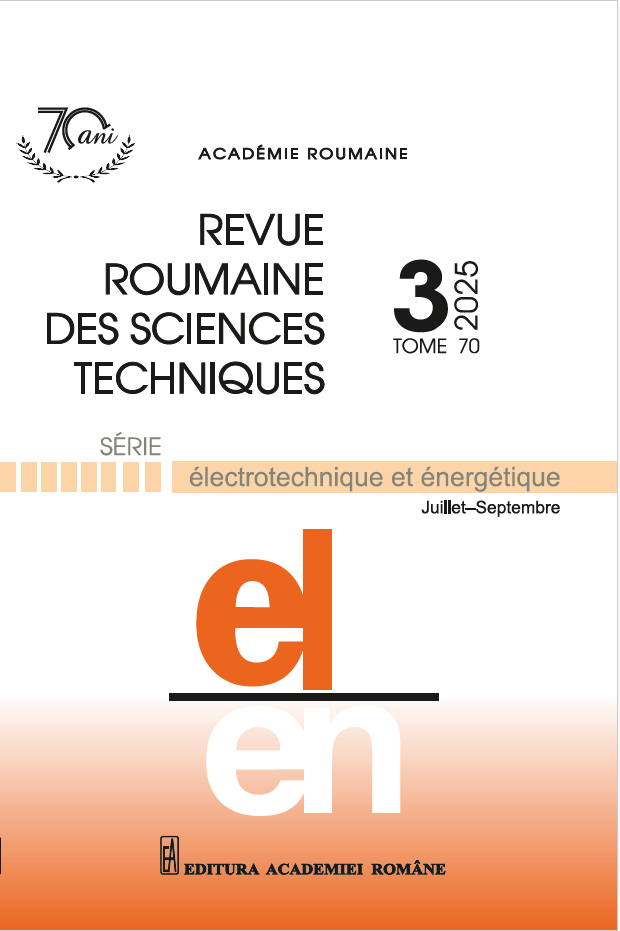GÉNÉRATION DE DONNÉES OPÉRATIONNELLES SYNTHÉTIQUES POUR LES APPLICATIONS D'APPRENTISSAGE PROFOND DANS LES LIGNES DE TRANSPORT D'ÉNERGIE
DOI :
https://doi.org/10.59277/RRST-EE.2025.3.2Mots-clés :
Réseau antagoniste génératif tabulaire conditionnel (CTGAN), Détection de défauts, Analyse en composantes principales (ACP)Résumé
Les algorithmes de protection des lignes de transport d'électricité basés sur l'apprentissage profond (DL) nécessitent d'importants volumes de données opérationnelles pour un apprentissage précis. Cependant, l'accès à ces données est souvent complexe en raison de leur confidentialité, de restrictions et de limitations propriétaires. Cet article propose une méthode de génération de données synthétiques combinant l'analyse en composantes principales (ACP) et un réseau antagoniste génératif tabulaire conditionnel (CTGAN). L'ACP réduit la dimensionnalité des données temporelles haute fréquence, permettant au CTGAN de fonctionner efficacement tout en conservant ses caractéristiques statistiques essentielles. Les données synthétiques générées présentent une forte corrélation avec les données réelles et enrichissent efficacement les ensembles de données limités. La validation à l'aide d'un modèle de classification des défauts basé sur LSTM a démontré une amélioration de la précision, passant de 50,93 % à 86,07 %. Une validation supplémentaire utilisant des données d'oscillations sous-synchrones démontre une applicabilité plus large. La méthode proposée est évolutive et prend en charge l'apprentissage par DL dans des scénarios où les données sont rares.
Références
(1) M.S. Uddin, et al., On the protection of power system: Transmission line fault analysis based on an optimal machine learning approach, Energy Reports, 8, pp. 10168–10182 (2022).
(2) K. Chen, C. Huang, J. He, Fault detection, classification and location for transmission lines and distribution systems: a review on the methods, High Voltage, 1, 1, pp. 25–33 (2016).
(3) A. Mukherjee, P. K. Kundu, A. Das, Transmission line faults in power system and the different algorithms for identification, classification and localization: a brief review of methods, Journal of The Institution of Engineers (India): Series B, 102, 4, pp. 855–877 (2021).
(4) C. Janiesch, P. Zschech, K. Heinrich, Machine learning and deep learning, Electronic Markets, 31, 3, pp. 685–695 (2021).
(5) D.E. Rumelhart, G.E. Hintont, Learning Representations by Back–Propagating Errors, Cognitive Modeling, The MIT Press, 2, pp. 3–6 (2002).
(6) C. González García, E. Núñez–Valdez, V. García–Díaz, C. Pelayo G–Bustelo, J. M. Cueva–Lovelle, A review of artificial intelligence in the internet of things, International Journal of Interactive Multimedia and Artificial Intelligence, 5, 4, p. 9 (2019).
(7) A. Gulli, P. Sujit, Deep Learning with Keras, Packt Publishing Ltd (2017).
(8) Y. Lecun, Y. Bengio, G. Hinton, Deep learning, Nature, 521, 7553, pp. 436–444 (2015).
(9) R. Wason, Deep learning: Evolution and expansion, Cogn Syst Res, 52, pp. 701–708 (2018).
(10) Y. Bengio, Y. Lecun, G. Hinton, Deep learning for AI, Commun ACM, 64, 7, pp. 58–65 (2021).
(11) S.R. Fahim, S.K. Sarker, S.M. Muyeen, S.K. Das, I. Kamwa, A deep learning based intelligent approach in detection and classification of transmission line faults, International Journal of Electrical Power & Energy Systems, 133, p. 107102 (2021).
(12) S.R. Fahim, Y. Sarker, S.K. Sarker, M.R.I. Sheikh, S.K. Das, Self-attention convolutional neural network with time series imaging-based feature extraction for transmission line fault detection and classification, Electric Power Systems Research, 187, p. 106437 (2020).
(13) F. Rafique, L. Fu, M. Hassan Ul Haq, R. Mai, Automatic features extraction by transfer learning for transmission line protection, Rev. Roum. Sci. Techn. – Électrotechn. Et Énerg., 68, 4, pp. 339–344 (2023).
(14) F. Rafique, L. Fu, R. Mai, End–to–end machine learning for fault detection and classification in power transmission lines, Electric Power Systems Research, 199, p. 107430 (2021).
(15) B.P. Bhattarai, et al., Big data analytics in smart grids: state–of–the–art, challenges, opportunities, and future directions, IET Smart Grid, 2, 2, pp. 141–154 (2019).
(16) L. Xu, M. Skoularidou, A. Cuesta–Infante, K. Veeramachaneni, Modeling tabular data using conditional GAN, Adv Neural Inf Process Syst, 32 (2019).
(17) I. Goodfellow, et al., Generative adversarial networks, Commun ACM, 63, 11, pp. 139–144 (2020).
(18) I. Goodfellow, et al., Generative Adversarial Nets, Advances in neural information processing systems, Curran Associates, Inc. (2014).
(19) T. Karras, T. Aila, S. Laine, J. Lehtinen, Progressive growing of GANs for improved quality, stability, and variation, 6th International Conference on Learning Representations, ICLR, pp. 1–26 (2018).
(20) H. Abdi, L.J. Williams, Principal component analysis, Wiley Interdiscip Rev Comput Stat, 2, 4, pp. 433–459 (2010).
(21) F. Zhang, J. Li, J. Liu, W. Gao, J. He, An improved interpolated DFT–based parameter identification for sub–/super–synchronous oscillations with Synchrophasors, IEEE Transactions on Power Systems, 38, 2, pp. 1714–1727 (2022).
(22) F. Zhang, Simulated synchrophasors in SSOs and phasor measurement data recorded during a subsynchronous oscillation incident in an actual power system, IEEE DataPort, 255, 15, pp.:6989-6994 (2025).
Téléchargements
Publiée
Numéro
Rubrique
Licence
(c) Copyright REVUE ROUMAINE DES SCIENCES TECHNIQUES — SÉRIE ÉLECTROTECHNIQUE ET ÉNERGÉTIQUE 2025

Ce travail est disponible sous licence Creative Commons Attribution - Pas d'Utilisation Commerciale - Pas de Modification 4.0 International.


